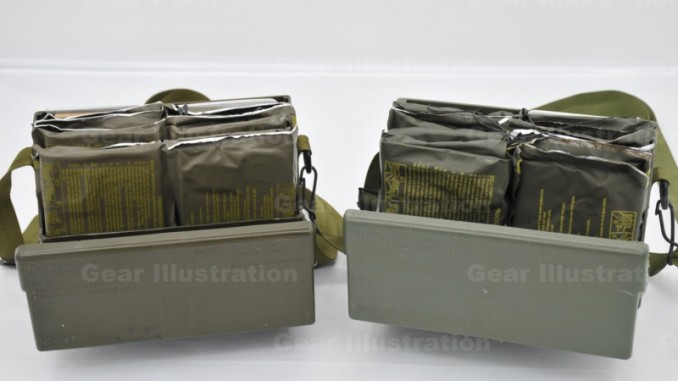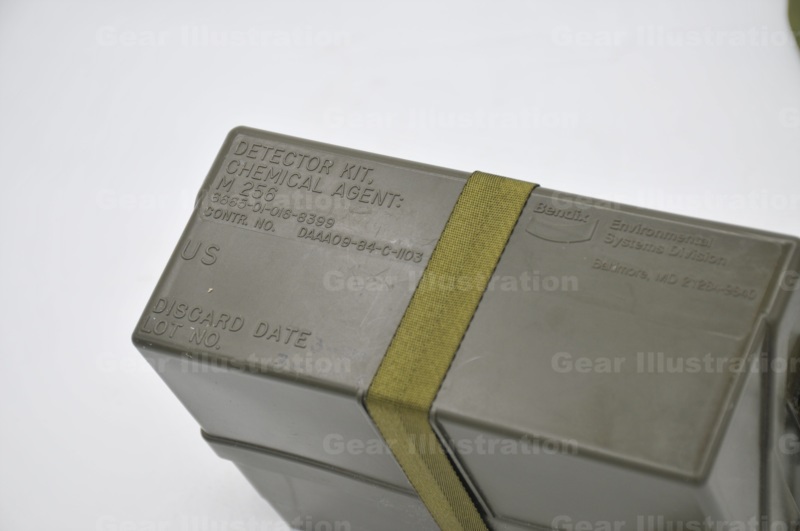
The M256A1 Chemical Agent Detector Kit is used to detect and identify blood, blister and nerve agents present either as liquid or as vapor. May be used to determine when it is safe to unmask, to locate and identify chemical hazards (reconnaissance), and to monitor decontamination effectiveness. The M256 is not an alarm; it is a tool used after soldiers have received other warnings about the possible presence of chemical warfare agents, and have responded by putting on their chemical protective clothing.
The M256 consists of a carrying case, a booklet of M8 paper, 12 disposable sampler-detectors individually sealed in a plastic laminated foil envelop, and a set of instruction cards attached by a lanyard to the plastic carrying case. The case is made from molded, high impact plastic and has a nylon carrying strap and a nylon belt attachment. The case measures seven inches high, five inches wide, and three inches in depth. The entire kit weighs 1.2 pounds. The kit can operate in temperatures ranging from minus 25 degrees Fahrenheit (-32 degrees Celsius) to 120 degrees Fahrenheit (49 degrees Celsius).
The M8 paper is used to test liquid substances for the presence of nerve agents and blister agents. It is similar to the litmus (pH) paper that is found in almost any laboratory in that a test result is indicated in both types of paper by a change in color. The difference is that M8 paper is specifically designed (dye-impregnated) to react to nerve agents and blister agents in liquid form (M8 Paper is also issued to soldiers as a separate piece of chemical detection equipment). The soldier blots the M8 paper on a suspected liquid agent and observes for color change. There is a color chart inside the front cover of the booklet for comparison. The M8 paper comes in 4″ x 2.5″ booklets, each containing 25 sheets of detector paper.
Each sampler-detector contains a square impregnated spot for blister agents, a circular test spot for blood agents, a star test spot for nerve agents, and a lewisite detecting tablet and rubbing tab. The test spots are made of standard laboratory filter paper. There are eight glass ampoules, six containing reagents for testing and two in an attached chemical heater. When the ampoules are crushed between the fingers, formed channels in the plastic sheets direct the flow of liquid reagent to wet the test spots. Each test spot or detecting tablet develops a distinctive color which indicates whether a chemical agent is or is not present in the air. The use of eel enzyme for the nerve test in place of horse enzyme provides for an improvement to the M256A1 Kit by detecting lower levels of nerve agent. Any type of mustard is also detectable as long as vapor is present.
By following the directions on the foil packets or in the instruction booklet, a soldier can conduct a complete test with the liquid-sensitive M8 paper and the vapor-sensitive sampler-detector in approximately 20 minutes.
A M256A1 trainer simulator was developed to provide realistic training while avoiding unnecessary exposure to potentially carcinogenic reagents in the M256A1 detector kit. The M256A1 trainer contains 36 pre-engineered detector tickets and an instruction booklet. The pre-engineered detector tickets show color changes comparable to those seen when the M256A1 detector kit is used in clean or contaminated environments.
Agents Detected:
- Hydrogen Cyanide / AC / Blood (cyanide)
- Cyanogen Chloride / CK / Blood (cyanide)
- Mustard / H / Blister
- Nitrogen Mustard / HN / Blister
- Distilled Mustard / HD / Blister
- Phosgene Oxime / CX / Blister
- Lewsite / L / Blister
- Nerve Agents / V and G / Nerve
Stock Number Reference:
| Name | NSN | Assign Date |
|---|---|---|
| Detector Kit, Chemical Agent; M256 | 6665-01-016-8399 | 1976-02-25 |
| Detector Kit, Chemical Agent; M256A1 | 6665-01-133-4964 | 1982-06-15 |



Source: ARMY STUDY GUIDE

